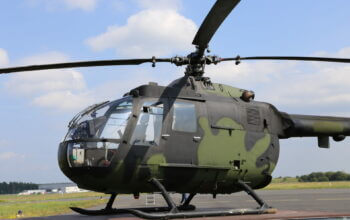Four years after Congress mandated crash-resistant fuel systems (CRFS) for all new-build helicopters in the U.S., the European Union Aviation Safety Agency (EASA) is contemplating similar rulemaking that could go a step further by requiring CRFS retrofits for some or all of the European helicopter fleet.

EASA on Nov. 11 published a Notice of Proposed Amendment (NPA) that outlines five possible approaches for improving the crash safety of helicopters operating in Europe, thousands of which lack CRFS. The proposals range from mandating CRFS for newly manufactured rotorcraft — similar to the requirement that took effect in 2020 in the U.S. — to requiring CRFS for all rotorcraft operating in Europe by either 2030 or 2038.
There is currently no helicopter CRFS retrofit mandate in the U.S., although there have been some efforts to push one through Congress. As previously reported by Vertical, while retrofit kits are now available for many helicopter models, the pace of voluntary adoption has been slow.
EASA has been on the receiving end of numerous recommendations from safety investigation authorities to mandate CRFS in helicopters. Most recently, the Norwegian Safety Investigation Authority (NSIA) recommended that EASA require CRFS for all helicopters delivered or imported to Europe, and prohibit commercial passenger flights with helicopters that are not so equipped.
The NSIA’s recommendations followed its investigation into the August 2019 crash of an Airbus H125 operated by Helitrans near Alta, Norway. Although the helicopter was almost new, it was not equipped with a crash-resistant fuel system, and erupted in flames after impacting the ground. All six people on board died in the accident, which the NSIA determined was likely otherwise survivable.
As a result of such recommendations, EASA included a CRFS rulemaking task in its European Plan for Aviation Safety 2022-2026. The NPA is one step in that task, which aims to implement regulatory change sometime in 2024.
EASA’s NPA includes cost-benefit analyses for each of the possible approaches, finding that in no case do the calculated benefits of regulatory action outweigh the estimated costs. For example, EASA guesses that requiring CRFS for newly manufactured rotorcraft would save 8.3 lives between 2025 and 2050, to which it assigns a present total value of 13.1 million euros (around US$13.6 million). That’s far less than the estimated 52.5 million euros ($54.5 million) in associated costs.
However, the NPA cautions that its own cost-benefit analyses don’t tell the full story. Notably, the estimated costs for implementing CRFS were provided by industry and “are considered excessive and very pessimistic,” the NPA states. The analyses do not monetize the benefits of avoiding injuries, damages, and higher insurance premiums, nor do they consider the costs of legal settlements associated with preventable post-crash fires, which have been as high as $100 million in the U.S.
Based on these additional factors, the NPA suggests that the most proportionate approach would be to mandate CRFS for all newly manufactured rotorcraft starting in 2025, and for all existing rotorcraft with five or more occupants as of 2030. Smaller rotorcraft could face a CRFS mandate starting in 2038.
The NPA is open for public comment through Feb. 13, 2023, after which EASA will review all comments received and submit an opinion to the European Commission on the appropriate regulatory action.








